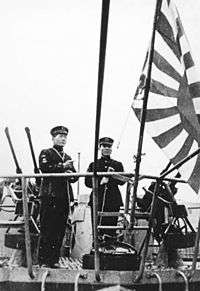Action of 13 May 1944
| ||||||||||||||||||||||||||||||
The Action of 13 May 1944 refers to the sinking of an Imperial Japanese submarine in the Atlantic Ocean during World War II. An American destroyer escort attacked the former German U-boat U-1224, which had been given to the Japanese Navy and renamed RO-501. The boat was the first of two Japanese vessels sunk in the European Theater of Operations.
Action
Due to arrangements made by German Vice Admiral Paul H. Weneker in 1944, a group of Japanese sailors under Lieutenant Commander Norita Sadatoshi were sent to Germany to receive training in submarine warfare. After they were given the recently launched U-1224 to sail back to Japan with a precious cargo of mercury, lead, steel, aluminum drawings, optical glass, blueprints for a IXC type U-boat and Messerschmitt Me 163A Komet jet aircraft. Allied intelligence discovered that the Japanese were sailing a submarine from Germany to Asia, so Task Group 22.2 (TG 22.2) of the United States Navy was ordered to intercept them. Lieutenant Commander Sadatoshi had no choice but to take his boat around the tip of Africa and this meant passing off the Cape Verde Islands where TG 22.2 operated.[1][2]

The group included the escort carrier USS Bogue and five destroyer escorts; USS Francis M. Robinson, Haverfield, Swenning, Willis and Janssen. TG 22.2 was on its first day of operations around the Cape Verdes on 13 May.[1] Lieutenant John E. Johansen in Robinson was patrolling alone a few hundred miles northwest of the Cape Verdes when at sunset about 19:00, her crew made a sound contact with a submarine. Johansen ordered his men to battle stations, and at a range of 825 yd (754 m) the Americans opened fire with hedgehog bombs which detonated over the area where the submarine was heard. A few moments later, Robinson was over the area itself and dropped a series of Mark 8 depth charges.[1]
Seven seconds later, two underwater explosions were heard, indicating that some of the hedgehogs hit and damaged RO-501. A few seconds after, three successive explosions from the depth charges sent up huge columns of water. Three minutes later, a loud roar was produced by another large underwater explosion, said to have killed fish up to a quarter of a league from the battle area. Thus, RO-501 was sunk with a loss of all 52 hands at position 18°8′N 33°13′W / 18.133°N 33.217°WCoordinates: 18°8′N 33°13′W / 18.133°N 33.217°W, a few miles from where USS Buckley sank U-66 after a famous battle.[1][2]
Aircraft from TG 22.2 later sank a second Japanese boat in the Atlantic, I-52, and was one of the most successful U.S. Navy squadrons which operated against submarines during the war. Francis M. Robinson received the Presidential Unit Citation and one battle star for destroying RO-501.
See also
References
- 1 2 3 4 "Sinking of RO 501". Desausa.org. 1944-05-13. Retrieved 2014-06-21.
- 1 2 "RO-501 SUBMARINE 1943-1944 - WRECK WRAK EPAVE WRACK PECIO". Wrecksite.eu. Retrieved 2014-06-21.
This article incorporates text from the public domain Dictionary of American Naval Fighting Ships. The entries can be found here and here.
